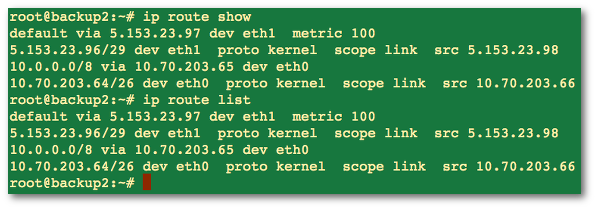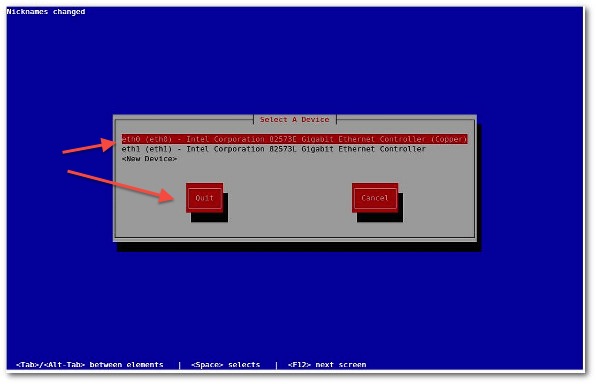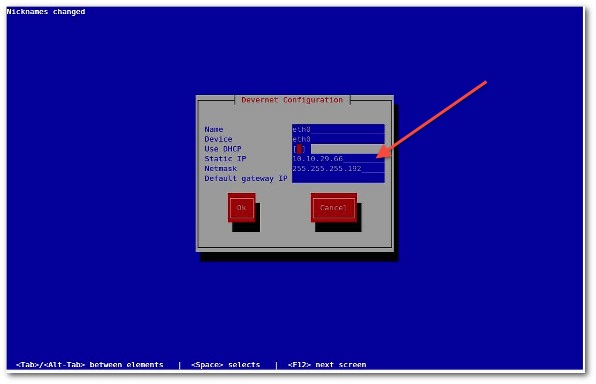For example under Red Hat/Fedora Linux you can add static router for eth0 network interface by editing /etc/sysconfig/network-scripts/route-eth0 file. Under Debian Linux add static route by editing /etc/network/interface file.
Task: Display Current Routing Table Using ip command
By using the ip command, you can setup and view static route. For example, to display current routing table you can type command:# ip route showSample output:
192.168.2.0/24 dev eth1 proto kernel scope link src 192.168.2.1 192.168.1.0/24 dev eth0 proto kernel scope link src 192.168.1.2 default via 192.168.1.254 dev eth0You can add static route using following command:
ip route add {NETWORK} via {IP} dev {DEVICE}
For example network 192.168.55.0/24 available via 192.168.1.254:
# ip route add 192.168.55.0/24 via 192.168.1.254 dev eth1Alternatively, you can use old good route command:
# route add -net 192.168.55.0 netmask 255.255.255.0 gw 192.168.1.254 dev eth1Linux Persistence Routes
The drawback of 'ip' or 'route' command is that, when Linux reboots it will forget static routes. So store them in configuration file. Static routing describes a system that does not implement adaptive routing. In these systems routes through a data network are described by fixed paths (statically). These routes are usually entered into the router by the system administratorRed Hat (RHEL) / CentOS / Fedora Linux Persistence Static Routing
You need to open /etc/sysconfig/network-scripts/route-eth0 file to define static routes for eth0 interface:# cat /etc/sysconfig/network-scripts/route-eth0Sample Output:
GATEWAY0=192.168.1.254 NETMASK0=255.255.255.0 ADDRESS0=192.168.55.0 GATEWAY1=10.164.234.112 NETMASK1= 255.255.255.240 ADDRESS1=10.164.234.132
How do I define static routing for network 10.0.0.0/8 via 10.9.38.65 router?
Open /etc/sysconfig/network-scripts/route-eth0:# vi /etc/sysconfig/network-scripts/route-eth0Append following line:
10.0.0.0/8 via 10.9.38.65Save and close the file. Restart networking:
# service network restartVerify new routing table:
# route -nDebian / Ubuntu Linux Persistence Static Routing
Exampleroute add -net 10.10.10.0 netmask 255.255.255.0 gw 192.168.1.1 dev eth0
route add -host 10.10.1.1 netmask 255.255.255.0 gw 192.168.1.1 dev eth0
This adds the route immediatly to the Kernel IP routing table. To confirm the route has been successfully, simply type the "route" command with no arguements:
Open configuration file /etc/network/interfaces
# cat /etc/network/interfacesOutput:
auto eth0 iface eth0 inet static address 192.168.1.2 netmask 255.255.255.0 gateway 192.168.1.254 up route add -net 192.168.2.0 netmask 255.255.255.0 gw 192.168.2.1 down route del -net 192.168.2.0 netmask 255.255.255.0 gw 192.168.2.1
Debian / Ubuntu Linux static routing for two interfaces:
auto lo
iface lo inet loopback
auto eth0
iface eth0 inet static
address 10.9.38.76
netmask 255.255.255.240
network 10.9.38.64
broadcast 10.9.38.79
### static routing ###
post-up route add -net 10.0.0.0 netmask 255.0.0.0 gw 10.9.38.65
pre-down route del -net 10.0.0.0 netmask 255.0.0.0 gw 10.9.38.65
auto eth1
iface eth1 inet static
address 204.186.149.140
netmask 255.255.255.240
network 204.186.149.128
broadcast 204.186.149.143
gateway 204.186.149.129
# dns-* options are implemented by the resolvconf package, if installed
dns-nameservers 10.0.80.11 10.0.80.12
dns-search nixcraft.in
http://www.cyberciti.biz/tips/configuring-static-routes-in-debian-or-red-hat-linux-systems.html
How to add a Permanent Static Route on Linux?
In a Linux system specifically on CentOS machine, most of the configurations relevant to networking, IP address and routes addition or manipulation is done and saved in /etc/sysconfig/network-scripts directory. Please go into the /etc/sysconfig/network-scripts/ directory and list the files just for your own understanding.[root@pbx2 ~]# cd /etc/sysconfig/network-scripts/
[root@pbx2 network-scripts]# ls
ifcfg-eth0 ifdown-eth ifdown-isdn network-functions
ifcfg-lo ifdown-ib ifdown-post route-eth0
so here you’d be able to see the files like above where the network information of our Linux server is stored.
As we discussed how to add a route on a
Linux server but it was not static and the route’s information gets
flushed away after rebooting the server. So we need to add a permanent
route so that it remains static on every reboot or even we execute the
restart command of the networking service. In order to add a permanent
static route, we need to create a new file in
/etc/sysconfig/network-scripts/ and have to store the route information
in that file which can be done as:
[root@pbx2 ~]# echo ‘192.168.2.55/24 via 192.168.2.1’ >> /etc/sysconfig
/network-scripts/route-eth0
Now in order to check, restart the networking service:[root@pbx2 ~]# service network restart
In order to get more satisfaction, reboot the server once and check again the routes on the server with following command:[root@pbx2 ~]# route –n
OR
[root@pbx2 ~]# netstat -r
The file should be looking like this:[root@pbx2 network-scripts]# cat route-eth0 192.168.2.55/24 via 192.168.2.1
http://linuxzilla.com/add-static-route-in-linux/
______________________________________________________________________
CentOS Linux: Add Static Routing
You can use any one of the following command line utility to add, delete, display, or manipulate the Linux kernel routing table on CentOS and friends:
| Tutorial details | |
|---|---|
| Difficulty | Easy (rss) |
| Root privileges | Yes |
| Requirements | CentOS/RHEL |
| Estimated completion time | 10m |
- ip command - A CentOS Linux command line tool to print / manipulate routing, devices, policy routing and tunnels.
- route command - Older command line utility to show or manipulate the Linux kernel routing table. I suggest that you use ip command instead of route command. This command exists for historical and compatibility reasons only.
- /etc/sysconfig/network - Edit this file to set default gateway IP address.
- /etc/sysconfig/network-scripts/route-ethX - Edit this file to set additional static gateway IP address.
CentOS: Displaying current routing table
Type any one of the following command:# netstat -nr
# route -n
# ip route listSample outputs:
Warning:
It is important that you configure routing correctly over ssh based
session; otherwise, you will be locked out due to wrong network
configuration.
CentOS Linux add a default gateway
In this example, route all traffic via 192.168.1.254 gateway connected via eth0 network interface. The following command will set a default gateway for both internal and external network (if any):# route add default gw 192.168.1.254 eth0OR
# ip route add 192.168.1.0/24 dev eth0How do I make routing changes persistent across CentOS Linux server reboots?
To set default gateway edit /etc/sysconfig/network as follows:# cat /etc/sysconfig/networkSample configuration file:
NETWORKING=yes ## server name ## HOSTNAME=server1.cyberciti.biz ## Default route ## GATEWAY=192.168.1.254 NETWORKING_IPV6=yes IPV6_AUTOCONF=no Save and close the file. Restart the networking service on CentOS Linux, type:
# service network restart
# ip route listTo verify new settings ping to the default gateway and external network:
# ping 192.168.1.254
# ping www.cyberciti.biz
# host google.comCentOS Linux static routing config for eth1 interface
The following is a sample route-eth1 file. The default gateway set to 192.168.2.254, interface eth1. The static route is 10.10.29.65 for 10.0.0.0/8 network:# cat /etc/sysconfig/network-scripts/route-eth1Sample configurations:
default 192.168.2.254 dev eth1 10.0.0.0/8 via 10.10.29.65 dev eth1
Alert: For eth0 interface use /etc/sysconfig/network-scripts/route-eth0 file. Avoid setting duplicate default gateways; either use /etc/sysconfig/network or /etc/sysconfig/network-scripts/route-ethX file. Do not use both files to configure default gateways.
A note about GUI/TUI tool
If you don't have X windows GUI (gnome/kde desktop) installed on CentOS server / system, than type the following command at shell prompt. This method can only set the default gateway. It can not be used to set additional static routing for interface. Type the following command:# system-config-network-tui &Select your Ethernet card such as eth0 or eth1 and hit [Enter] or [F12] special key to configure IP properties for selected NIC:
You can obtain an IP address using DHCP or setup IP address manually. Once an IP address assigned, click on the Ok button to save the changes. See how to configure networking on CentOS / RHEL / Fedora Linux tutorial for more information.







rutas persistentes al reiniciar el servidor
ResponderEliminarnano /etc/rc.local
/sbin/route add -net 190.6.132.0 netmask 255.255.255.0 gw 192.168.176.
dev eth0